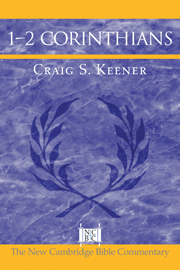Book contents
- Frontmatter
- Contents
- List of Abbreviations
- I INTRODUCTION TO CORINTH AND 1 CORINTHIANS
- II SUGGESTED READING FOR CORINTH AND 1 CORINTHIANS
- III COMMENTARY ON 1 CORINTHIANS
- IV INTRODUCTION TO 2 CORINTHIANS
- V SUGGESTED READING FOR 2 CORINTHIANS
- VI COMMENTARY ON 2 CORINTHIANS
- Author Index
- Scripture and Apocrypha Index
- Index of Extrabiblical Jewish and Christian Sources
- Other Greco-Roman Sources
- Subject Index
I - INTRODUCTION TO CORINTH AND 1 CORINTHIANS
Published online by Cambridge University Press: 05 June 2012
- Frontmatter
- Contents
- List of Abbreviations
- I INTRODUCTION TO CORINTH AND 1 CORINTHIANS
- II SUGGESTED READING FOR CORINTH AND 1 CORINTHIANS
- III COMMENTARY ON 1 CORINTHIANS
- IV INTRODUCTION TO 2 CORINTHIANS
- V SUGGESTED READING FOR 2 CORINTHIANS
- VI COMMENTARY ON 2 CORINTHIANS
- Author Index
- Scripture and Apocrypha Index
- Index of Extrabiblical Jewish and Christian Sources
- Other Greco-Roman Sources
- Subject Index
Summary
I am happy to dedicate this commentary to two of my colleagues at the Palmer (formerly Eastern) Seminary of Eastern University: Ronald J. Sider and Samuel Escobar.
This commentary is meant to serve the needs of pastors and other students of the Bible. Although I include documentation for interested students to follow up, especially on otherwise difficult-to-trace claims about the ancient world, the focus is Paul's message and its value for readers today. I currently am organizing my research for a scholarly commentary on 1 Corinthians, but even my background notes for it already run to over seven times the space available for this commentary. Space constraints thus permit only cursory treatments of passages and documentation. (Nevertheless, although this is not the “scholarly” version, I hope that even scholars will find points of value here, especially ancient parallels to Paul's argumentation.)
We hear in Paul's correspondence his intimate and sometimes difficult pastoral relationship with the Corinthians. But whereas some principles he articulates seem straightforward, much sounds foreign to modern ears. Paul affirms the value of singleness in part because the end is near (1 Cor 7:26, 29); head coverings in part because of the angels (11:10) or because nature supports them (11:14); and the resurrection body in part on the analogy of heavenly “bodies” like the stars or moon. All of these arguments made sense for Paul's contemporaries, but modern readers find them difficult to apply directly.
- Type
- Chapter
- Information
- 1-2 Corinthians , pp. 1 - 10Publisher: Cambridge University PressPrint publication year: 2005



